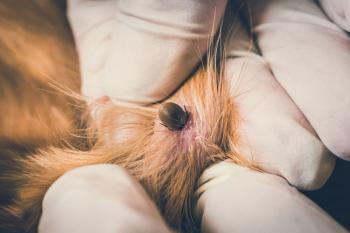
Help Your Clients Outsmart Foxtails This Summer
The two main dangers posed by Foxtails are foreign-body reactions and infections.
Summer conjures up images of people and their pets enjoying a taste of the warmer weather. That translates to more time outside, whether it’s hiking in the mountains or relaxing in the yard. But there is a real danger for companion animals: one that’s sly and underestimated, yet can be a silent killer if not detected and treated properly: the Foxtail plant.
Foxtail Facts
Foxtails are appropriately named since the plant resembles the tail of a fox. “Foxtail” is a generic term that’s often applied to several species of wild grasses, but is specifically associated with a type of wild barley (Hordeum jubatum) that is indigenous to the western United States.
1
The Foxtail plant is common all up and down the West Coast but has also spread across the country, according to the US Forest Service, populating all but seven states: Florida, Georgia, Hawaii, Louisiana, North Carolina, South Carolina, and Virginia. It’s also found throughout most of Canada, as well as in some areas of Mexico.
1
The weed tends to grow in grassland areas and is common along roadsides, trails, and areas that include human disturbance, such as dumps. It also grows well along the edges of salt marshes, on flatlands and Western prairies, and in irrigated meadows.
1
Viewed under a magnifying glass, each bristle is covered with an infinite number of microscopic barbs. If an animal brushes by the dry plant (or steps on it, sniffs it, rolls on it, etc.), the microscopic barbs catch on its fur.
2
Sometimes the awn falls from the animal’s fur on its own. However, if the awn doesn’t fall out, or it hooks into another area of the animal, that’s when the trouble starts.
2
Dogs often pick up Foxtails between their toes; the flexing motion of the dog’s feet helps the foxtail work deeper and deeper between the toes, until it pierces the skin (and keeps going). It’s also extremely common for dogs to get Foxtails in their nostrils as they sniff and smell in the grass on a walk.
2
Two Main Dangers of Foxtails
The two main dangers posed by Foxtails are foreign-body reactions and infections. The levels of the threat range from irritating, as when a Foxtail invades the webbing between a dog’s toes and causes an abscess, to medical emergencies.
3
Foxtails in the ears can rupture eardrums or cause chronic ear infections, while foxtails in the eyes can lead to blindness. Inhaled foxtails can affect the lungs, causing infections and necessitating major surgery — including the removal of lung lobes.
3
Even if the Foxtail doesn’t cause the problem, it can create a conduit for outside infection.
3
Dirt-borne bacteria, such as Actinomyces bovis and Nocardia asteroides, can be introduced into the body cavity by a burrowing awn and can wreak havoc.
1,3
Pneumonia is not an uncommon result when an awn enters a lung. Discospondylitis, an infection of the spinal vertebra and intervertebral discs, can be introduced by Foxtail migration and can cause conjunctivitis if the Foxtail becomes lodged in the eye.1,3 A number of other opportunistic infections, such as Blastomycosis, can occur when an awn enters a dog’s body. It is more likely for a dog to suffer a Foxtail in the nose, ear, or paw.
4
Foxtail Prevention Tips for Your Clients
Here are some ways clients can take action with their pets:4
- Examining their pet's coat during Foxtail season -- generally May through December -- especially if the pet has walked in open fields.
- Brushing their dog as necessary, and looking closely for pointy Foxtail awns in thick or feathery fur.
- Checking their dog’s face and ears for Foxtails. Don't forget to have clients look in and around their pet's mouth and gums.
- Carefully checking their dog's paw pads, especially between the toes.
- Using tweezers to remove any foxtails in plain sight
The easiest way for your clients to prevent Foxtail problems is to keep their animals out of overgrown, grassy areas and remove any Foxtail plants they find in their yard. They should also consider trimming their dog's hair during Foxtail season, especially if one spot in the animal's fur is more susceptible.
4
Truly the best way to eliminate Foxtail danger is to avoid the plant completely, but with even a minor incident, a quick response is the best medicine.
References
- University of California, Davis: Foxtails Pose Autumn Threat to Dogs. 2012; 101-106.
- Pitcairn, R. Dr. Pitcairn's Complete Guide to Natural Health for Dogs & Cats, 2005;7 9-83.
- Acker, R. Field Guide to Dog First Aid: Emergency Care for the Outdoor Dog. 2015; 22-29.
- Beware of Foxtail Seeds this Summer. Whole Dog Journal website. http://www.whole-dog-journal.com/issues/6_8/features/Beware-Foxtail-Seeds_5563-1.html. Published August 2003. Updated March 2016. Accessed June 19, 2016.
Newsletter
From exam room tips to practice management insights, get trusted veterinary news delivered straight to your inbox—subscribe to dvm360.




